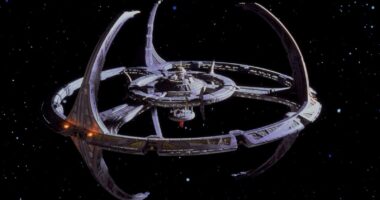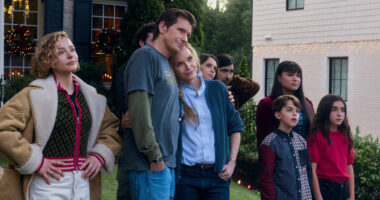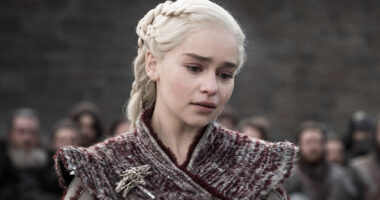Share this @internewscast.com
Since 2002, every film featuring “Spider-Man” in the title has earned at least $190 million at the American box office. Similarly, with live-action “Batman” films, only “Batman and Robin” has failed to achieve more than $163 million in North America. Aside from that 1997 outlier, “Batman” films are virtually guaranteed to be profitable. However, while superhero franchises like Spider-Man and Batman consistently succeed, the same cannot be said for the Fantastic Four.
Despite being iconic in comic book lore, the Fantastic Four’s journeys on the big screen have repeatedly fallen short at the box office. Starting with 2005’s “Fantastic Four,” each subsequent installment has earned less than the one before it, both domestically and internationally. This disappointing trend climaxed with 2015’s “Fantastic Four,” which earned less during its entire run in North America than “Fantastic Four: Rise of the Silver Surfer” did in its opening three days eight years earlier.
As Marvel Studios gears up to launch its faithful reboot, “The Fantastic Four: First Steps,” aiming to change their fortunes, it’s important to consider why these films have struggled compared to other comic book adaptations. There are several recurring issues that have consistently beset these projects, such as persistent problems with casting and production quality, ineffective marketing strategies, and stiff competition from other superhero films. All these and other challenges highlight the unfortunate truth that, at least until 2025, “Fantastic Four” movies have experienced the reverse of the box office success seen with franchises like “Spider-Man” and “Batman.”
Fantastic Four films have had quality issues
There are a number of complex reasons why the “Fantastic Four” movies have come up short financially. Sometimes, however, it’s down to the simplest factors. In this case, the “Fantastic Four” features have been constantly plagued by poor reviews and audience reception. Even back in 2005, when the very first big-budget live-action “Fantastic Four” film hit theaters, critics blasted the title as lacking the fun and heart of “The Incredibles” and “Spider-Man 2.”
The overstuffed “Fantastic Four: Rise of the Silver Surfer” got even worse reviews, with comic book fans especially chastising the 2007 project for its radical overhauling of Galactus. The lower box office haul of “Rise of the Silver Surfer” than its predecessor, meanwhile, showed that the middling reputation of 2005’s “Fantastic Four” hadn’t inspired a loyal fanbase for multiple outings from Marvel’s First Family.
2015’s “Fantastic Four,” though, exceeded both of its 2000s ancestors in terms of dreary reception. Moviegoers and critics alike gave the tormented production a pass thanks to its bleak tone and inert drama. This entry even scored the worst CinemaScore ever for a comic book movie at the time of its release, a vivid signal of just how much audiences rejected it. The very name “Fantastic Four” now conjures up moviegoing memories of poor superhero films, and without any of these films securing solid word-of-mouth, no installment has snagged the legs necessary to become a box office sensation.
The movies didn’t produce or feature major movie stars
Dating back to then-unknown Christopher Reeve headlining 1978’s “Superman,” it’s often been said that superhero movies rely more on their brand names than famous leads. That’s often true, but several superhero sagas have gotten a boost in the long term by launching or exploiting movie stars. Hugh Jackman was nobody when the first “X-Men” debuted, but his subsequent star profile certainly gave that mutant saga cultural longevity. Robert Downey Jr. was a massive draw for many Marvel Cinematic Universe features. Securing famous supporting players like Michael Caine or Anne Hathaway in various “Dark Knight” movies also secured the attention of moviegoers.
In contrast, the three “Fantastic Four” movies released before 2025 couldn’t get any kind of extra juice from iconic faces. These titles relied on either lesser-known actors or individuals who wouldn’t become movie stars until later in their careers. Principal “Fantastic Four” cast members like Michael Chiklis, Ioan Gruffudd, Kate Mara, Jamie Bell, and Toby Kebbell (among others) are talented folks in their own right, but they’re not household names. Even Michael B. Jordan, who played Johnny Storm/The Human Torch in 2015’s “Fantastic Four,” didn’t become a star until three months after “Four” was released, with the arrival of “Creed.”
Some superhero sagas can get by with largely unknown casts. The “Fantastic Four” movies, though, needed all the help they could get. Without a Jackman or Downey Jr. around, these movies had even fewer resources to escape box office despair.
Filmmakers have been timid over the outlandish source material
While the unreleased 1994 “Fantastic Four” movie embraced the weirdness of the “Fantastic Four” comics, right down to an unabashedly theatrical incarnation of Doctor Doom, the three subsequent bigger-budgeted “Fantastic Four” movies have had a much more negative relationship to these integral elements of the property’s mythos.
In the pages of Marvel Comics, the Fantastic Four engaged in heightened adventures that introduced fanciful fixtures of the Marvel mythos like the Inhumans, the Skrulls, and the very first incarnation of Kang the Conqueror. However, the films have busied themselves with diluting or playing down those far-fetched elements, replacing all the fun stylized comic book shenanigans with generic comedic beats and blockbuster movie material. Ironically, this approach, meant to make the characters more palatable to mainstream audiences, only reinforced why “Fantastic Four” films never take off financially — the lack of risk-taking ensured that they didn’t stand out to the general public.
Eschewing the comics’ bizarre nature also meant eschewing elements that could have separated “Fantastic Four” from other mid-2000s and mid-2010s superhero movies. Imagining Galactus as a cloud instead of the colossal purple giant of the comics elicited shrugs from normal people and comic book geeks alike. As idiosyncratic 2020s hits like “Sinners” and “Everything Everywhere All at Once” demonstrate, boldness often results in big box office. “Fantastic Four” movies have never realized that despite the characters’ comic book legacy.
The films suffered from a lack of bold creative voices
Recruiting horror directors for superhero films has a positive track record, thanks to the work of Tim Burton, Sam Raimi, James Wan, James Gunn, and others. Comedy veterans taking on these projects, however, have yielded much more mixed results. Just look at how Phases Four and Five of the Marvel Cinematic Universe were hurt by delegating so many scripts to “Rick and Morty” veterans with no experience writing feature-length movies.
The perils of enlisting comedy directors to tackle these titles was reinforced by Tim Story’s two “Fantastic Four” movies in the 2000s. Leaning into the nonchalant character-driven laughs of his sleeper hit comedy “Barbershop” could have seen Story deliver a unique entry into the superhero movie landscape. Instead, he helmed his “Fantastic Four” titles with a generic, frustratingly vague creative voice that could have come from anyone.
Josh Trank, helmer of 2015’s “Fantastic Four,” went through an even more tumultuous time trying to leave his fingerprints on the tortured project. The end result was a movie that satisfied nobody, least of all Trank. All told, the “Fantastic Four” movies to date have refused to embrace distinctive voices that could deliver the personality of superhero cinema hits like “Black Panther” and “Spider-Man.”
Constant superhero movie competition has hurt the Fantastic Four
Another recurring problem for the “Fantastic Four” movies is that they’ve never been the standout superhero features in the marketplace. Whether in 2005 or 2015, the box office potential for these titles has been inherently limited thanks to other major films arriving at the same time. 2005’s “Fantastic Four,” for instance, had some of its thunder stolen by November 2004’s infinitely superior “The Incredibles.” More lucrative, kid-friendly summer 2005 titles like “Charlie and the Chocolate Factory” and “Star Wars: Episode III — Revenge of the Sith” also diluted the movie’s financial potential.
Two summers later, “Fantastic Four: Rise of the Silver Surfer” entered a moviegoing landscape where fellow Marvel Comics adaptation “Spider-Man 3” was the No. 1 movie of the year domestically. Against that record-shattering behemoth, “Silver Surfer” was an also-ran before its theatrical release even began. Then there was August 2015’s “Fantastic Four,” which opened three weeks after “Ant-Man.” Though one of the lowest-grossing Marvel Studios titles domestically, “Ant-Man” still more than tripled the North American gross of “Fantastic Four,” proving to be the kind of crowdpleasing, upbeat superhero cinema that the population craved in 2015.
That filmmaking mold was something “Fantastic Four” didn’t come close to delivering. Granted, none of these three movies were anywhere near good enough to suggest they would have become box office sensations even in the best of times. But the “Fantastic Four” films have constantly run into super competitive landscapes for superhero fare that have only exacerbated their inherent flaws.
Inescapable tonal problems dogged these films
Both 21st-century incarnations of “Fantastic Four” movies have suffered from similar tonal problems. The Tim Story installments from 2005 and 2007 as well as the 2015 Josh Trank film struggled to make their respective atmospheres compelling. The original two “Fantastic Four” films aimed for a zippier, comedy-driven aesthetic, but actors like Ioan Gruffudd and Julian McMahon were absolutely terrible at handling comedy. The slipshod scripts of these titles also ensured that they lacked the punchy, precise comedy of better, funnier superhero films like “Shazam!” or “Guardians of the Galaxy.”
2015’s “Fantastic Four,” meanwhile, was a mopey mess lacking vibrancy or humanity in its downbeat depiction of securing superpowers. Who would want to hang out with this miserable vision of Marvel’s First Family? These tonal issues stemmed from how each creative team assembled to adapt the Fantastic Four for the silver screen seemed uncomfortable with these characters and their world. In the process, none of these films displayed the kind of confidence marking the biggest superhero movies.
Whether it’s darker features like “The Dark Knight” or lighter creations like “Thor: Ragnarok,” you have to commit to your aesthetic. Creative confidence tends to be infectious. The “Fantastic Four” movies, meanwhile, have felt like half-hearted efforts all along. With this inescapable issue plaguing both major incarnations of the team to date, audiences have opted to buy tickets to other, more tonally coherent summer blockbusters.
Extravagant budgets inspire box office despair from the get-go
One numbers-based problem the “Fantastic Four” movies have faced in their quest for box office glory has been their budgets. Superhero films do not come cheap, but the “Fantastic Four” films have often been overpriced compared to their box office value.
2005’s “Fantastic Four” had a reasonable $87.5 million budget, which ensured it would turn a profit on a $330 million worldwide haul. Its sequel, “Rise of the Silver Surfer,” however, cost 50% more than its predecessor, with a $130 million budget. That sizable increase only resulted in a $289 million worldwide gross, noticeably down from its predecessor’s haul. These two films clearly showed there was a ceiling for pre-MCU “Fantastic Four” titles, and the price tag for 2015’s reboot should have been adjusted accordingly to that reality.
Instead, 2015’s “Fantastic Four” cost $155 million to produce, a bigger budget than that same summer’s “Ant-Man.” To be profitable at the worldwide box office, the film needed to earn at least $395 million worldwide, a much larger global sum than 2005’s “Fantastc Four.” That haul never came, though, with “Fantastic Four” only reaching $167 million worldwide. 2010s superhero titles like “Shazam!” or “Venom” showed that you could make these movies for more modest prices, but the “Fantastic Four” movies kept spending big-league superhero money, even with extremely limited appeal that led to box office doom.
The films were obsessed with chasing trends
In the comics, the Fantastic Four set the tone for subsequent Silver Age Marvel exploits, establishing cultural precedents rather than trying to follow the paths of other costumed crime-fighters. Unfortunately, the “Fantastic Four” films have gone down more derivative creative paths that have limited their box office potential. “Fantastic Four” titles have tried so hard to emulate other movies that audiences couldn’t even tell them apart from past, superior blockbusters.
The 2000s “Fantatsic Four” films, for instance, yearned to capture the magic of Sam Raimi’s “Spider-Man” entries. Those titles, though, oozed sincerity and visual imagination. Neither “Fantastic Four” nor “Rise of the Silver Surfer” offered such qualities, so people opted to just watch the “Spider-Man” movies instead.
2015’s “Fantastic Four” followed in the footsteps of “Batman Begins” and “Casino Royale” by offering a grittier interpretation of the franchise. Unfortunately for “Fantastic Four,” while “Begins” and “Royale” were hits, so many other darker, more grounded reboots bit the dust at the box office, including 2010”s “Robin Hood” and even the brighter follow-up to 2012’s brooding “The Amazing Spider-Man.” What worked for specific movies was not a recipe for box office success for all. In the comics, the Fantastic Four proved popular because they were unique. Their movies, conversely, have constantly flopped because they were indistinguishable from others.
There was a meager pop culture legacy to draw from
When new “Spider-Man” and “Batman” movies open, they’re building on decades of nostalgia and tradition — it’s almost comforting to know these properties will always be fixtures of an average summer moviegoing season. The Fantastic Four simply don’t have that. When 2015’s “Fantastic Four” rolled around, it just reminded viewers of two previous superhero movies they didn’t care for. The idea of these characters coming back just sounded like a threat, not a fun extension of positive moviegoing memories. Without a favorable pre-existing legacy to build from, the “Fantastic Four” films are inherently pushing a boulder up a hill at the box office.
In contrast, the original “Guardians of the Galaxy” or “Iron Man” movies had it easier. They also didn’t have positive cinematic legacies to exploit, but that also meant they didn’t have any negative theatrical experiences tainting their arrival. These were blank slate features that audiences hadn’t seen before. The “Fantastic Four” sequels, meanwhile, have contended with a pre-existing negative reception that “Rise of the Silver Surfer” and 2015’s “Fantastic Four” haven’t proven strong enough to counter. Thus the box office performances of “Fantastic Four” movies can’t lean on glorious cinematic legacies like “Spider-Man” and “Batman” installments can.
Absolutely bizarre marketing stunts have hurt the Four
Before 2016’s “Deadpool” even hit theaters, people were sold on the film thanks to an irreverent marketing campaign that was unlike any other promotional blitzkrieg for a superhero movie. When one of these costly comic book movies is heading to theaters, studios want audiences excited by each new poster or trailer. Otherwise, these titles kick off their respective box office runs on a toxic note that’s impossible to recover from.
In contrast to “Deadpool,” the pre-release hype for “Fantastic Four: Rise of the Silver Surfer” was plagued by negativity over a bizarre promotional stunt gone wrong. An attempt to stamp the Silver Surfer on select U.S. quarters to promote the movie was declared illegal by the U.S. Mint. This snafu encapsulated how the various “Fantastic Four” movies have been constantly derailed by poorly planned-out marketing campaigns.
While films like “Logan” or even the original “Suicide Squad” got all-time great trailers, the 21st-century “Fantastic Four” films had rudimentary trailers with little imagination or personality in their editing or song choices. 2015’s “Fantastic Four” had an especially bamboozling marketing campaign, with elements like a Denny’s tie-in menu undercutting the ominous tone conveyed by the film’s trailers. These erratic and infamous pre-release promotional strategies almost made box office failure inevitable for the three “Fantastic Four” movies.
There’s a dearth of memorable villains
What’s a good superhero movie without a memorable villain? People may show up for the costumed crime-fighter, but they often leave the theater talking about folks like Willem Dafoe’s Green Goblin, Josh Brolin’s Thanos, or Heath Ledger’s Joker. The “Fantastic Four” movies, however, never delivered on the kind of meaty antagonists that drive so many superhero movie smash hits.
The two Tim Story-directed features, for example, kept rehashing a diminished version of Doctor Doom (Julian McMahon). They also featured a nebulous incarnation of Galactus that was hard to get invested in. 2015’s “Fantastic Four” was even worse on this front. Only in its third act did the film even have a proper comic book baddie in the form of a younger Victor Von Doom (Toby Kebbell). Once he appeared, this iteration of Doctor Doom had no personality or menace, and his design was also laugh-worthy.
The inherently heightened realm of superhero movies means that actors and screenwriters can go full ham in bringing baddies to life. Folks love watching characters like Cate Blanchett’s Hela or Patrick Wilson’s Orm — the sort of outlandish foes who couldn’t exist in any other genre. The “Fantastic Four” films, though, have never followed through on this potential. Massive juggernauts like “Spider-Man” and “The Dark Knight” exploited the might of great comic book antagonists. The forgettable “Fantastic Four” foes merely inspired equally dreary box office totals.







